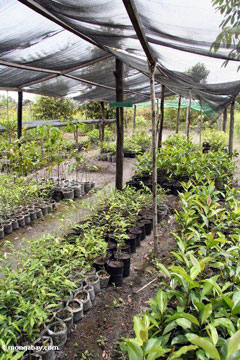Regrowing the rainforest
Regrowing the rainforest
Boyce Thompson Institute for Plant Research
March 30, 2008
Can you rescue a rainforest? The answer may be yes
|
|
Half a century after most of Costa Rica’s rainforests were cut down, researchers from the Boyce Thompson Institute took on a project that many thought was impossible – restoring a tropical rainforest ecosystem.
When the researchers planted worn-out cattle fields in Costa Rica with a sampling of local trees, native species began to move in and flourish, raising the hope that destroyed rainforests can one day be replaced.
Carl Leopold and his partners in the Tropical Forestry Initiative began planting trees on worn-out pasture land in Costa Rica in 1992. For 50 years the soil was compacted under countless hooves, and its nutrients washed away. When it rained, Leopold says, red soil appeared to bleed from the hillsides.
The group chose local rainforest trees, collecting seeds from native trees in the community. “You can’t buy seeds,” Leopold says. “So we passed the word around among the neighbors.” When a farmer would notice a tree producing seeds, Leopold and his wife would ride out on horses to find the tree before hungry monkeys beat them to it.
 Key biodiversity area boundaries over CI’s forest cover and clearance 1975-2000 project. Tree resprouting offers hope in former pastures of Brazil’s cerrado |
The group planted mixtures of local species, trimming away the pasture grasses until the trees could take care of themselves. This was the opposite of what commercial companies have done for decades, planting entire fields of a single type of tree to harvest for wood or paper pulp.
The trees the group planted were fast-growing, sun-loving species. After just five years those first trees formed a canopy of leaves, shading out the grasses underneath.
“One of the really amazing things is that our fast-growing tree species are averaging two meters of growth per year,” Leopold says. How could soil so long removed from a fertile rainforest support that much growth?
Leopold says that may be because of mycorrhizae, microscopic fungi that form a symbiosis with tree roots. Research at Cornell and BTI shows that without them, many plants can’t grow as well. After 50 years, the fungi seem to still be alive in the soil, able to help new trees grow.
Another success came when Cornell student Jackeline Salazar did a survey of the plants that moved into the planted areas. She counted understory species, plants that took up residence in the shade of the new trees. Most plots had over a hundred of these species, and many of the new species are ones that also live in nearby remnants of the original forests.
Together, these results mean that mixed-species plantings can help to jump-start a rainforest. Local farmers who use the same approach will control erosion of their land while creating a forest that can be harvested sustainably, a few trees at a time.
“By restoring forests we’re helping to control erosion, restore quality forests that belong there, and help the quality of life of the local people,” says Leopold.
That quality-of-life issue is drinking water. It’s in scarce supply where forests have been destroyed, since without tree roots to act as a sort of sponge, rain water runs off the hillsides and drains away.
Erosion is also out of control. “You might drive on a dirt road one year, and then come back the next to find it’s a gully over six feet deep,” says Leopold. “It’s a very serious problem.”
Does the experiment’s success mean that rainforests will one day flourish again? Fully rescuing a rainforest may take hundreds of years, if it can be done at all.
“The potential for the forest being able to come back is debatable,” Leopold says, but the results are promising.
“I’m surprised,” he said. “We’re getting an impressive growth of new forest species.” After only ten years, plots that began with a few species are now lush forests of hundreds. Who knows what the next few decades – or centuries – might bring?
The findings were published in the March 2008 issue of Ecological Restoration.